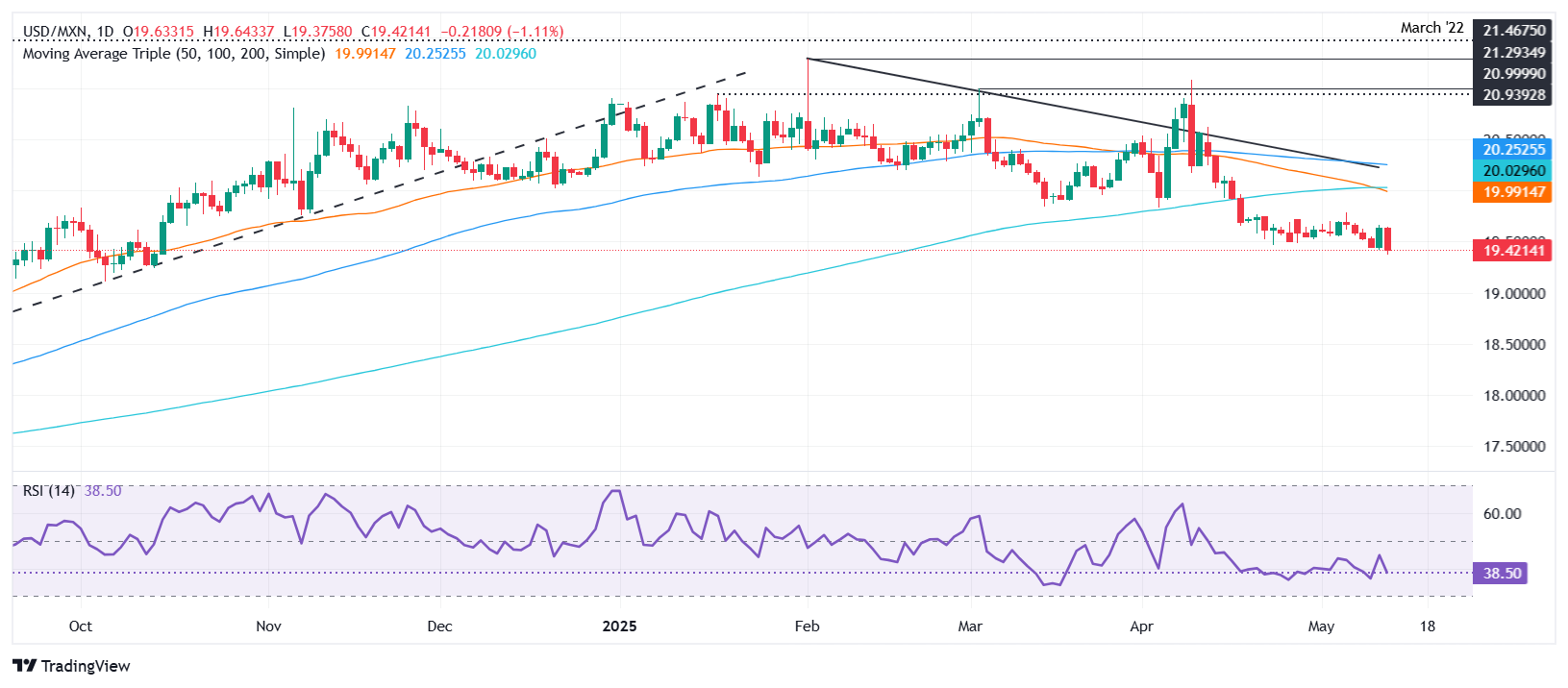Mexican Peso hits YTD high as US CPI miss, tariff truce sink USD
- Mexican Peso strengthens sharply, clearing 19.50 support with eyes on 19.00 amid risk-on momentum.
- April US CPI data misses expectations; core inflation holds steady, weakening the Greenback.
- US-China 90-day tariff rollback lifts global sentiment; S&P 500 posts over 1% gain.
The Mexican Peso (MXN) rallied to a new year-to-date (YTD) high against the US Dollar (USD) after a softer-than-expected inflation report in the United States (US) weighed on the Greenback. Also, an improvement in risk appetite boosted the emerging market (EM) currency’s appeal. At the time of writing, the USD/MXN trades at 19.41, down more than 1%.
Wall Street ended Tuesday’s session in the green, erasing the stock market losses for the year as market participants assessed US President Donald Trump's decision to dial back tariffs applied to Chinese products. The 90-day truce and the reduction of tariffs agreed between the US and China improved risk appetite, as portrayed by the S&P 500 climbing over 1%.
Consequently, risk-sensitive currencies in the FX space, such as the Peso, extended their gains as the USD/MXN cleared the crucial 19.50 psychological support level before sliding towards the 19.00 figure.
Mexican Peso capitalizes on US Dollar weakness after US CPI miss
In the US, April’s headline inflation on a year-over-year basis was in line with forecasts. The so-called core, which excludes volatile items, was unchanged.
Daily digest market movers: Mexican Peso advances as US Dollar falls
- Traders are awaiting Banxico’s monetary policy decision on May 15, in which the Mexican institution is expected to reduce rates for the seventh consecutive meeting.
- Banco de México -also known as Banxico- is expected to reduce interest rates by 50 basis points (bps), according to a poll revealed by Reuters. This would be the seventh straight meeting that Banxico cut rates.
- Recently, Mexico’s Economy Minister, Marcelo Ebrard, announced that the USMCA revision will commence in the second half of 2025.
- On Monday, Mexico’s Industrial Production slowed in March, as revealed by the Instituto Nacional de Estadística, Geografía e Informática (INEGI). This, along with GDP figures that barely triggered a technical recession, would likely undermine the Mexican currency.
- Recent data revealed that Mexico’s economy is undergoing a deceleration while inflation Mexico’s inflation data for April, which expanded above expectations in both headline and core figures, would not prevent Banxico from prolonging its easing cycle.
- Worth noting that investors reduced their bets that the Federal Reserve (Fed) might only cut rates twice instead of thrice, as revealed by data from the Chicago Board of Trade (CBOT). The December 2025 fed funds rates futures contract shows that market players expect 57 basis points of easing.
- Therefore, monetary policy divergence between the Fed and Banxico might add pressure on the Peso and push USD/MXN exchange rate higher.
USD/MXN technical outlook: Mexican Peso advances as USD/MXN tumbles below 20-day SMA
The USD/MXN has fallen to a new year-to-date (YTD) low of 19.41, with the pair remaining bearish-biased after achieving a series of successive lower highs and lower lows. Additionally, prices are below the 20-day Simple Moving Average (SMA) at 19.58. A daily close below 19.50 may exacerbate a test of the 19.00 figure. On further weakness, the next target would be the August 19, 2024 swing low of 18.59.
Conversely, if USD/MXN climbed past the 19.50 area and reached a three-day high of 19.66, past the 20-day Simple Moving Average (SMA) before retreating somewhat.

Mexican Peso FAQs
The Mexican Peso (MXN) is the most traded currency among its Latin American peers. Its value is broadly determined by the performance of the Mexican economy, the country’s central bank’s policy, the amount of foreign investment in the country and even the levels of remittances sent by Mexicans who live abroad, particularly in the United States. Geopolitical trends can also move MXN: for example, the process of nearshoring – or the decision by some firms to relocate manufacturing capacity and supply chains closer to their home countries – is also seen as a catalyst for the Mexican currency as the country is considered a key manufacturing hub in the American continent. Another catalyst for MXN is Oil prices as Mexico is a key exporter of the commodity.
The main objective of Mexico’s central bank, also known as Banxico, is to maintain inflation at low and stable levels (at or close to its target of 3%, the midpoint in a tolerance band of between 2% and 4%). To this end, the bank sets an appropriate level of interest rates. When inflation is too high, Banxico will attempt to tame it by raising interest rates, making it more expensive for households and businesses to borrow money, thus cooling demand and the overall economy. Higher interest rates are generally positive for the Mexican Peso (MXN) as they lead to higher yields, making the country a more attractive place for investors. On the contrary, lower interest rates tend to weaken MXN.
Macroeconomic data releases are key to assess the state of the economy and can have an impact on the Mexican Peso (MXN) valuation. A strong Mexican economy, based on high economic growth, low unemployment and high confidence is good for MXN. Not only does it attract more foreign investment but it may encourage the Bank of Mexico (Banxico) to increase interest rates, particularly if this strength comes together with elevated inflation. However, if economic data is weak, MXN is likely to depreciate.
As an emerging-market currency, the Mexican Peso (MXN) tends to strive during risk-on periods, or when investors perceive that broader market risks are low and thus are eager to engage with investments that carry a higher risk. Conversely, MXN tends to weaken at times of market turbulence or economic uncertainty as investors tend to sell higher-risk assets and flee to the more-stable safe havens.

